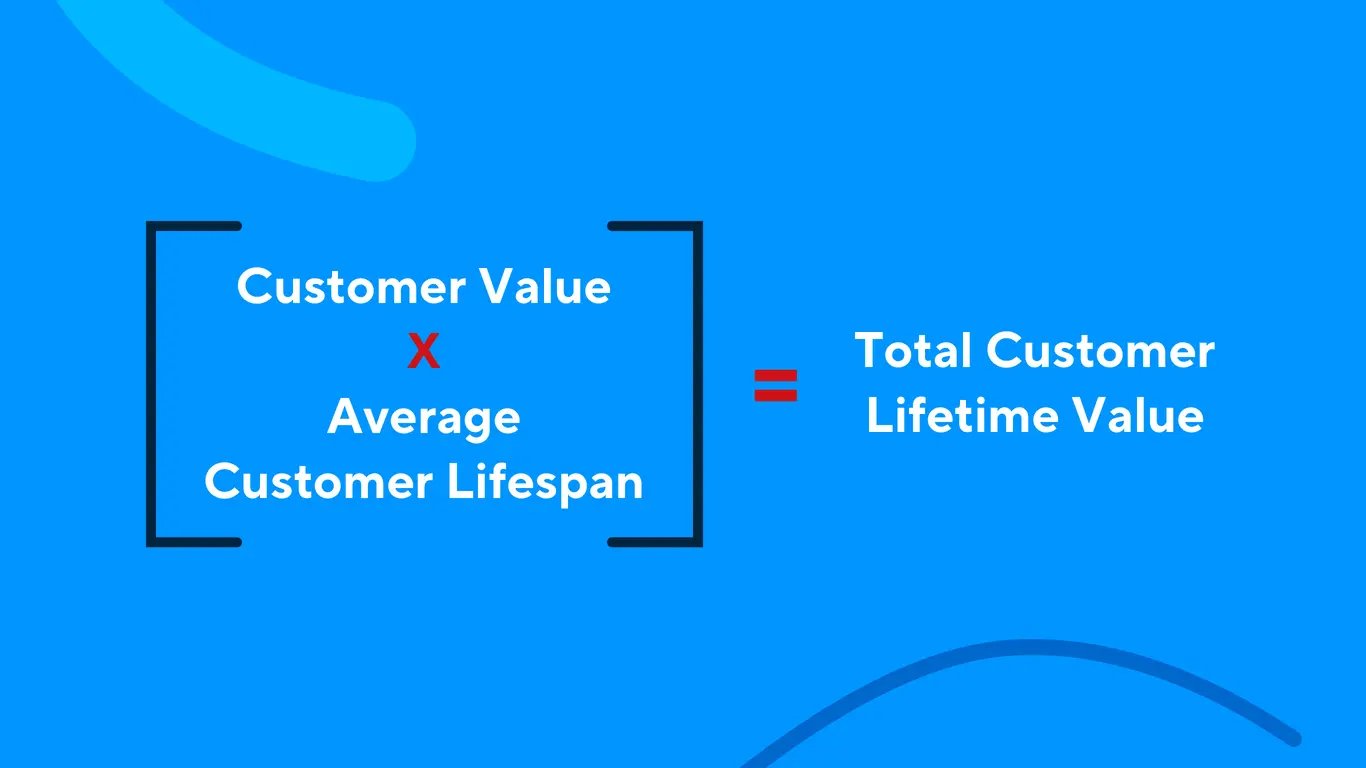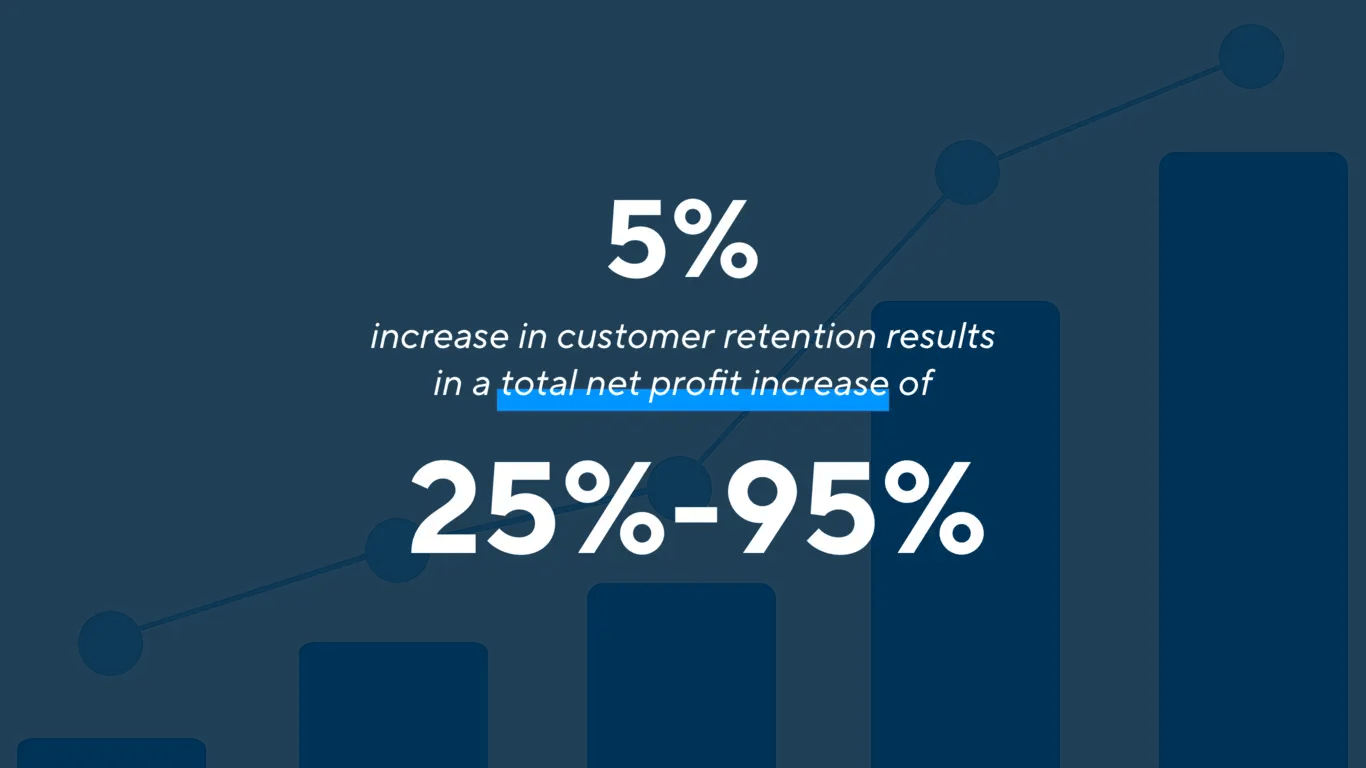
Customer acquisition is all about building relationships. Customer retention is about making these relationships last beyond an initial purchase. The strength of these relationships can determine total customer lifetime value.
In basic terms, customer lifetime value, or CLV, is typically measured by the total revenue a customer generates for a company throughout the business relationship.
However, this term means a lot more than that and as a metric, it can make or break your business in a lot of ways. The total value can tell you if your customers have a positive or negative experience throughout their journey and can help you determine if your customer experience management strategies are working.
So, let’s dive in to what customer lifetime value is, how to effectively measure it, and why it matters to businesses of all sizes across all industries.
What is Customer Lifetime Value?
Customer lifetime value is a metric that represents the total net profit that a business can expect to generate from an average customer throughout the business relationship.
This takes into account:
- Customer’s initial purchase
- Repeat purchases
- Length of time a customer may stay with a company
- Cost to the business to acquire and retain a customer
These factors are all variables in calculating the lifetime value of a customer. Customer lifetime value is a key identifier that can help you set strategies and make data-driven decisions for your business. By tracking and measuring your customer lifetime value, you can gain insights to improve your customer experience overall.
How to Measure Customer Lifetime Value?
To calculate your customer lifetime value, you multiply your customer value (the total net profit a customer brings in) by the average customer lifespan. To accurately measure the lifetime value of a customer, you need to take into consideration any expenses associated with obtaining a client and supporting them.

Using these totals, you can calculate the cost of acquisition of customers, as well as the cost your business may spend over their lifetime to determine an estimate of the net profit a client will bring to your company, which is the customer lifetime value. Costs your business spends could include marketing costs, salaries, commissions, onboarding and customer support expenses, hardware, etc.
For example, for recurring revenue models, business leaders would consider:
- How much customers pay to sign up
- How many terms (months or years) customers typically stay with the business
- The cost of sales and marketing materials to acquire a customer
- Onboarding costs
- Ongoing operational costs
Business leaders would then determine at what point they make a profit from that customer and therefore receive back those costs associated with obtaining the customer.
If you sell multiple products or services, you can even break down your CLV by product, highlighting which products or features are retaining customers the most. This way, you can allocate funds properly to marketing, sales, and even customer success to drive these products that ultimately bring in the most value.
Why is Customer Lifetime Value Important?
By determining their overall customer lifetime value, business leaders can drive business decisions to focus on business growth, customer retention, and profitability that ultimately feed into the customer experience.
Let’s share some of the key initiatives that customer lifetime value can help businesses move forward.
1. Budget planning and forecasting
First, customer lifetime value can determine a business’ financial viability and stability. If a business spends more money on acquiring and providing services to a customer than the customer spends on the business’ products and services, the company is burning more money than it’s earning and may not be viable. The long-term financial outlook for the company will not be positive.
Knowing your customer lifetime value will help you plan your business’ budget and forecast for the future.
2. Setting business metrics
Your total customer lifetime value can also help you determine many business metrics such as your:
- Overall pricing structure
- Discount model
- Go-to-market strategy
- Contracted term length
For example, based on your overall customer lifetime value, you can discover if it makes financial sense to organize your pricing on a month-to-month, quarterly, or yearly model.
3. Building customer retention strategies
Knowing the lifetime value of a customer can also help you develop strong retention strategies while reducing the strain on your team. In some organizations, there’s a big focus on getting customers in because sales representatives have targets to hit, but not as much of a focus on retention.
If your business isn’t focusing on retention or customer lifetime value and your customers are leaving at a higher rate than your sales team can bring them in, then your business won’t be able to grow. This brings us to business growth.
4. Driving business growth
If you have a strong retention strategy, you are able to service customers for a long period of time and your sales team can focus more on business growth rather than simply grinding every month to reach quotas. By focusing on retention, you will actually increase your customer lifetime value to drive profitability.
In fact, a 5% increase in customer retention results in a total profit increase of 25%-95%, with 65% of a company’s purchases coming from returning customers.

And you don’t need us to tell you that business growth should be your main priority. If clients are nurtured throughout the customer journey and have a positive customer experience, your customer lifetime value will increase and drive business growth through profitability.
How Can I Increase Customer Lifetime Value?
The bottom line is that there is no single magic potion to automatically increase your customer lifetime value, but what it comes down to is a strategic combination of efforts across the business.
Multiple teams contribute to maximizing and increasing your business’ overall customer lifetime value, from sales to marketing and customer support. Positive experiences occur across every part of the customer journey and across multiple touchpoints. It can start with the usability of your company website, like how easy it is for customers to navigate through it or understand your product offering and pricing.
It often all comes down to what problem you’re solving. So the number one thing you can do to increase customer lifetime value is to identify your customers’ common pain points and then look at ways to solve and even eliminate them.
It’s also important to be proactive to identify potential issues before they occur, which can help you set expectations throughout the customer journey, starting from the moment customers make a purchase.
How to Maximize Customer Lifetime Value?
While there is no single solution to increase and maximize customer lifetime value, there are a number of strategies you can use that feed into the customer experience to enhance that value.
Here are some of the ways we focus on maximizing customer lifetime value through enhancing the customer experience at net2phone.
1. Product and service upgrades
We regularly contact our customers to let them know about hardware upgrades and the newest updates to our plans and products to ensure they have the most updated and secure products.
2. Proactive touchpoints
Through working with our clients, we’ve identified areas during a customer’s journey where they may experience confusion or potential difficulties using the net2phone system as more users are added to accounts, new services are added onto their contract, etc. We regularly check in with our customers to hopefully eliminate issues before they occur.
For example, when a new administrator is hired on our customer accounts, they would have missed the initial onboarding when their employer first started using the net2phone system. We send a series of emails, share videos and webinars, and reach out to them personally via telephone to ensure they don’t experience frustration with our service during the transition.
3. CSAT scores
After orders and customer support tickets are closed, we use automation triggers to send out customer satisfaction surveys where customers can easily select a 1-5 rating on the service they received. We address any rating that is below a 5 to pinpoint where we can improve.
We may reach back out to customers regarding their feedback to improve their service or we can address issues internally with more training opportunities for our own team members to improve their interactions. We also actively encourage our high-scoring clients to leave reviews or to join our reference program. Having great customer advocates is really beneficial to both our Sales and Marketing teams.
4. Streamlining communication
We work to streamline all communication and ensure we are being clear and concise. We have a clear Service-Level Agreement (SLA), and we leverage our status page to notify clients if ourselves, our partners, or even internet service providers (ISPs) are experiencing issues that may affect their services. Our sales, customer support, and customer success representatives are very clear to set expectations with clients and explain product features.
Lastly, consistent internal communication within your own team is key. All your teams should be aligned and to ensure all of the above strategies work. Your team should work to continue to improve identify key risks or opportunities against your CLV.
How to Improve Customer Lifetime Value with Enhanced Communication

There are many tools out there that can help you measure customer lifetime value and overall customer satisfaction. From CRM tools to automation software and virtual chatbots that help companies provide timely responses to customer queries, it can be challenging to know where to start when seeking out the right solution for your business.
We think the best area to focus on right out of the gate is communication. Retention is about building lasting relationships with customers with clear and consistent communication. And this is where Contact Center as a Service (CCaaS) solutions really shine, allowing businesses to connect with their customers like never before.
One powerful tool that is designed to enhance customer experiences from every angle is uContact, net2phone’s contact center cloud solution. For businesses that deal with a lot of different customer interactions, uContact allows users to manage their many different customer interactions from one single screen, which can reduce response times. It also offers businesses an omnichannel experience that allows them to connect with their customers through a variety of different communication channels, from voice interactions over the phone to direct messages through platforms like WhatsApp. Users can provide support to customers faster, which can result in happier customers that will stay with you longer.
Related: What Is An Omnichannel Contact Center And Why It Matters?
If you are able to communicate with your customers faster and they know they can count on you, this establishes a sense of trust in your business that will last.
In a world in which positive customer experiences is the norm, you must focus on shaping every interaction that a customer has with your brand to be a positive one, whether it’s a visit to your website or a message exchange through social media. The more positive interactions a customer has with your brand, the more likely they are to become loyal customers. In fact, 81% of customers will make an additional purchase due to a positive customer experience.
Related: How to create a solid customer experience management strategy?
Focusing on strong communication with your customers will build stronger interactions over time, which can translate to more sales and higher customer retention, which will all build in to boosting customer lifetime value.
Shaping the Customer Experience and Redefining Customer Lifetime Value
Customer lifetime value is an important metric that can really define your business and boost revenues over time. By focusing on this aspect, you can ensure you are retaining customers just as much as you’re gaining new customers and help sustain business growth.
It’s also important that your team knows that they all play a vital part in increasing the lifetime value of a customer, it’s not the responsibility of one team alone. Sales, marketing, technical support, customer success, and more must work together to shape positive customer experiences that build lasting customer relationships.
Learn more about how you can shape better customer experiences and increase your customer lifetime value with uContact and speak to one of our experts today!




